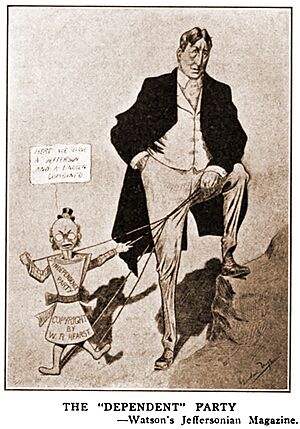Independence Party (United States) facts for kids
Quick facts for kids
Independence Party
|
|
|---|---|
| Chairman | William Randolph Hearst |
| Founded | 1906 |
| Dissolved | 1914 |
| Preceded by | Municipal Ownership League |
| Headquarters | New York City, NY |
| Newspaper | Hearst Newspapers |
| Ideology | Reformism Merit system Progressivism |
| Colors | Bronze (party's medal color) |
The Independence Party, also known as the Independence League, was a political party in the United States. It didn't last very long. A powerful newspaper owner named William Randolph Hearst started it in 1906.
This party took over from an earlier group called the Municipal Ownership League. Hearst had run for Mayor of New York City in 1905 with that group.
After doing well in a race for Governor of Massachusetts in 1907, the party aimed for the Presidency. They held a big meeting in 1908 to choose their candidates. However, the party only got about 83,000 votes across the country in the 1908 election. After that, it quickly stopped being a national political force.
The Independence League of New York kept putting forward candidates in New York state. This continued until the state election in 1914.
Contents
How the Independence Party Started
In 1905, William Randolph Hearst, a very rich newspaper publisher, ran for Mayor of New York City. He ran with the Municipal Ownership League. Hearst wanted to bring "reform" to the city. He was against the powerful Tammany Hall political group.
Hearst almost won the election. He lost by a very small number of votes. There were even claims of cheating in the election.
After this loss, the Municipal Ownership League changed its name. It became the Independence League of New York. This new name sounded less like a socialist group.
In 1906, Hearst tried for another political job. He ran for Governor of New York. He ran on a "fusion ticket" with the Democratic Party and the Independence League. A "fusion ticket" means two parties join together to support the same candidates. Even though Hearst lost, some other candidates on his ticket won.
Similar Independence Leagues were also active in other states. These included California and Massachusetts. In Massachusetts, the party's candidate, Thomas L. Hisgen, got many votes in the 1907 election. He even finished second, ahead of the Democratic Party's candidate. This made it seem like a new national party could become very important.
Choosing a President: The 1908 Convention
Because Thomas Hisgen did well in Massachusetts, the Independence League decided to become a national party. They called themselves the Independence Party. They held a big meeting in Chicago in 1908 to choose their presidential candidate. This meeting started on July 27, 1908. The hall was decorated with red, white, and blue colors.
Many people thought Hisgen would easily win the nomination. But the decision was not easy. It took three votes for the delegates to choose a candidate.
During the meeting, one delegate tried to nominate William Jennings Bryan. Bryan was the candidate for the Democratic Party. This caused a huge uproar and angry shouts from the crowd. People were so angry they tried to get to the speaker. The speaker was eventually stopped and removed from the meeting. He was told he couldn't nominate someone who wasn't part of the Independence Party.
After much chaos, the voting finally began. On the first vote, Hisgen got the most votes. But he didn't have enough to win yet. After a second vote, Hisgen was very close to winning. Finally, in the early morning of July 29, Hisgen won the nomination. John Temple Graves was chosen as his running mate for Vice-President.
What the Party Believed In: The Platform
The Independence Party created a list of things they believed in, called a "platform." They said that big companies were corrupt. They also said that the government wasted money. They believed that monopolies (when one company controls everything) charged too much. They also thought high tariffs (taxes on imported goods) and corrupt "political machines" hurt people. A "political machine" is a group that controls politics in a city or state.
The party said both the Republican and Democratic parties were to blame. The Independence Party wanted to "take control of public affairs" from selfish people. They wanted the government to work "for the common good."
The party's platform also supported:
- Stopping corrupt machine politics.
- An eight-hour work day for workers.
- Stopping judges from using special orders to end worker strikes.
- Creating a Department of Labor to help workers.
- Making workplaces safer.
- Setting up a central bank for the country.
They were also against companies keeping blacklists of striking workers. They didn't want prison workers making goods for sale. The party also wanted to use the initiative and referendum system. This system lets citizens vote directly on laws. They also wanted people to have the power to "recall" elected officials. This means citizens could vote to remove an official from office.
Even though some of their ideas sounded a bit like social democracy, the party said it was "a conservative force." They wanted to protect American freedom and independence.
The Party's Final Years
The national Independence Party fell apart after the 1908 election. In that election, Hisgen and Graves got less than one percent of all the votes.
Hearst tried to run for Mayor of New York again in 1909. He also ran for lieutenant governor in 1910. But he lost both times. The New York Independence League continued to nominate candidates for Governor and Lieutenant Governor of New York. This lasted until the state election in 1914.


